Evidence Action has supported the Government of India’s National Deworming Day program since 2015; our technical support at national and state level includes the periodic assessment of worm burden, to help determine treatment strategy. We recently conducted an assessment of survey methodologies to inform the best and most cost-effective approach for these surveys, which is the topic of this blog; results from the surveys will be published separately.
Soil-transmitted helminths (STH) are a group of parasitic worms, causing infections in approximately 1.5 billion individuals globally. The mainstay of STH control, as recommended by the World Health Organization (WHO), has been mass drug administration using albendazole or mebendazole, with interventions such as increasing access to water, sanitation and hygiene also recommended. Evidence Action’s Deworm the World Initiative partners with governments to support school-based deworming programs that regularly undertake mass drug administration, and we have been partnering with Indian state and national governments since 2011. In India, children aged 1-19 years have been regularly dewormed using albendazole since 2015, as part of the Government of India’s National Deworming Day. Evidence Action, in partnership with the High Level Scientific Committee, provides data and technical guidance to the Government of India to inform policy and National Deworming Dayobjectives and strategy for STH control. As part of our technical support to the Government of India, we have conducted prevalence and intensity surveys to assess the burden of STH in 9 states, both before (baseline) and after (follow-up) treatment, providing data to inform appropriate treatment strategies and assess the impact of multiple rounds of deworming (“impact assessment” surveys) to inform decisions around revised treatment strategies. As more states successfully conduct multiple, high-coverage deworming rounds, we plan to support additional impact assessment surveys.
School-based surveys
Although National Deworming Day treats children aged 1-19 years, all STH surveys conducted in India prior to 2018 assessed prevalence and intensity of STH infection in school-age children aged 5-10 years. School-based surveys are recommended by the WHO as an efficient mechanism for surveying school-age children. 2017 WHO guidelines encompass treatment for preschool-age children, school non-attending children, adolescent girls, and women of reproductive age. Thus, the global community has been determining how to measure the burden of STH in broader cohorts, including whether school-age children are a valid proxy for these other population groups. Whilst the WHO provides guidance for conducting school-based STH surveys for school-age children, there has been no standardized protocol available to survey other cohorts. To address this gap, with approvals from the Government of India, we developed an expanded cohort, community-based survey methodology aimed at evaluating statewide STH prevalence and intensity in the at-risk cohorts targeted by National Deworming Day: preschool-age children (aged 1<5 years); school-age children (aged 5<13 years); and adolescents (aged 13<20 years).
Piloting a novel methodology for surveying expanded cohorts
We piloted our expanded cohort survey methodology in late 2018 in two states – Chhattisgarh and Himachal Pradesh. These surveys had a primary objective of assessing the statewide prevalence and intensity of STH in each of the three aforementioned cohorts. Secondary objectives were: (i) to assess the changes in prevalence and intensity of STH among school-age children in these states over time; (ii) to update STH prevalence maps,, enabling improved decisions regarding surveying and treatments; (iii) to determine whether changes to National Deworming Day treatment strategy were required in these states; and (iv) to estimate the association between household and individual risk factors and STH infection in these states. Additionally, we assessed both the expanded cohort and school-based survey methodologies against a range of criteria related to the feasibility of implementation, with results informing recommendations to the Government of India about future surveying methodologies for National Deworming Day.
The expanded cohort surveys indicated significant reductions in STH prevalence in both states since 2015 (the findings will be published in due course but are not the subject of this post). To determine feasibility of implementation, we evaluated the expanded cohort and school-based survey methodologies, with analysis of total implementation costs indicating that expanded cohort surveys were 1.6-1.7 times more expensive than school-based surveys. On a per-site basis, expanded cohort surveys were 2.4-3.8 times more expensive than school-based surveys. An epidemiological assessment of the benefits and disadvantages of expanded cohort surveys relative to school-based surveys indicated that, for the primary objective of assessing STH burden, there was no statistical difference in burden found amongst the three surveyed age groups. Thus, in these states, school-age children could be considered a valid proxy for non-school cohorts to assess STH burden, and there was no additional gain from expanded cohort surveying that would have informed program-level decision-making on STH treatment frequencies.
However, for some secondary objectives such as investigating risk factor associations with infections, there were different significant WASH factors observed in different cohorts in Chhattisgarh. This could make the case for building in cohort-specific hygiene messaging within the program, and/or for conducting operational research within the state to ascertain most effective platforms for these messages. If prevalence within a certain cohort is suspected to be different from the school-age children population such that an expanded cohort survey would add value to refining a treatment strategy, an expanded cohort methodology could be a cost-effective means of assessing the burden in that additional cohort.
School-based surveys versus expanded cohort community-based surveys: the path forward
The High Level Scientific Committee has deliberated on the findings and feasibility analysis of the two expanded cohort surveys. While recognizing that both school-based and expanded cohort methodologies have benefits and challenges, the Committee recommended that the school-based approach be used for future prevalence and intensity surveys for National Deworming Day in India, given that surveying school-age children only through a school-based approach would provide statistically similar results more cost-effectively. The Committee recognized the value in determining the prevalence in different population cohorts in certain scenarios, such as understanding STH burden in smaller pockets, or for exploratory purposes, like devising treatment strategies for adults. The Committee agreed that such studies could be undertaken on a case-by-case basis with its approval. In accordance with these recommendations, the Government of India determined that school-based prevalence surveying (impact assessment) will continue to be the methodology of choice for India’s current National Deworming Day program.
In summary, the expanded cohort methodology we developed and piloted in Chhattisgarh and Himachal Pradesh has been determined to be very epidemiologically robust, however the choice of methodology must be informed by the objective of the survey. The expanded cohort methodology could have utility in India and elsewhere if, for example, there is a need for future treatment strategies to be devised for additional at-risk cohorts, such as women of reproductive age or adult cohorts. For the ongoing assessment of India’s National Deworming Day, we and other agencies undertaking follow-up surveys will employ the school-based methodology given its robustness for understanding worm burden to inform deworming treatment strategy.



